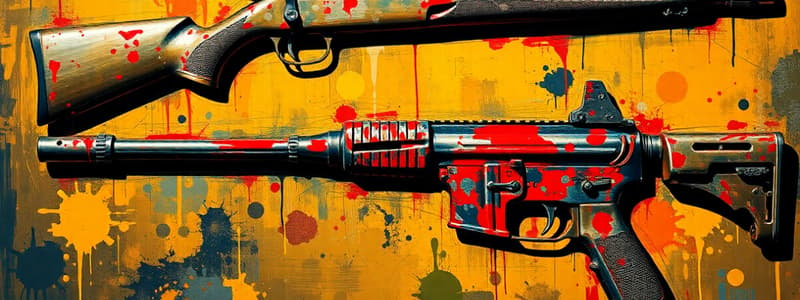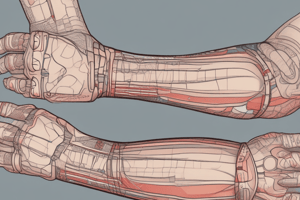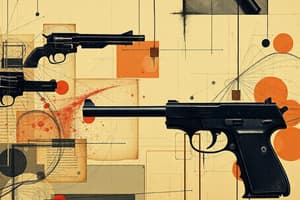Podcast
Questions and Answers
What is the defining feature of rifled weapons that contributes to the bullet's motion?
What is the defining feature of rifled weapons that contributes to the bullet's motion?
- Smooth interior bore
- Spiral grooves with lands (correct)
- Large caliber measurement
- Short barrel design
Which component of a cartridge ignites the propellant powder in the firing mechanism of rifled weapons?
Which component of a cartridge ignites the propellant powder in the firing mechanism of rifled weapons?
- The primer (correct)
- The firing pin
- The bullet
- The shell casing
What is meant by the term 'caliber' in the context of rifled weapons?
What is meant by the term 'caliber' in the context of rifled weapons?
- The velocity of the bullet
- The weight of the bullet
- The length of the barrel
- The distance between two opposite lands (correct)
Which of the following is NOT a characteristic of firearm wounds?
Which of the following is NOT a characteristic of firearm wounds?
What type of powder utilizes nitroglycerine or nitrocellulose?
What type of powder utilizes nitroglycerine or nitrocellulose?
Which type of weapon relies on the absence of spiral grooves within the barrel?
Which type of weapon relies on the absence of spiral grooves within the barrel?
What happens during the rapid burning of the propellant powder in a cartridge?
What happens during the rapid burning of the propellant powder in a cartridge?
What signifies the unique 'family characteristics' of a bullet from a specific weapon?
What signifies the unique 'family characteristics' of a bullet from a specific weapon?
What is the primary effect of gas released during gunfire?
What is the primary effect of gas released during gunfire?
What is the phenomenon called when unburned gunpowder particles enter and deposit in the skin?
What is the phenomenon called when unburned gunpowder particles enter and deposit in the skin?
What type of injury results from the bullet entering the skin and causing direct damage?
What type of injury results from the bullet entering the skin and causing direct damage?
How does the lubrication effect manifest at the margin of a gunshot wound?
How does the lubrication effect manifest at the margin of a gunshot wound?
What effect does carbon monoxide in the gunfire gases have on tissues?
What effect does carbon monoxide in the gunfire gases have on tissues?
What causes the wound diameter to shrink after a bullet exits the skin?
What causes the wound diameter to shrink after a bullet exits the skin?
Which effect is caused by the muzzle of a gun when fired close to the skin?
Which effect is caused by the muzzle of a gun when fired close to the skin?
What type of cavity is created by the continued acceleration of air or tissue during a gunshot?
What type of cavity is created by the continued acceleration of air or tissue during a gunshot?
What characteristic wound pattern is associated with new shotgun ammunition devices?
What characteristic wound pattern is associated with new shotgun ammunition devices?
Which factor is the most significant in determining the range of shotgun pellets?
Which factor is the most significant in determining the range of shotgun pellets?
What typically happens to wads traveling over a distance of 5 meters from the gun muzzle?
What typically happens to wads traveling over a distance of 5 meters from the gun muzzle?
In the investigation of firearm injuries, which question aims to determine whether the wound is an inlet or an exit?
In the investigation of firearm injuries, which question aims to determine whether the wound is an inlet or an exit?
What complication is most likely to occur if a firearm injury affects the medulla oblongata?
What complication is most likely to occur if a firearm injury affects the medulla oblongata?
Which statement accurately describes exit wounds produced by non-rifled weapons?
Which statement accurately describes exit wounds produced by non-rifled weapons?
What is a possible consequence of a firearm injury to the abdomen?
What is a possible consequence of a firearm injury to the abdomen?
What is a common visible sign of firearm residue on a victim with an entrance wound?
What is a common visible sign of firearm residue on a victim with an entrance wound?
What is the typical shape of the exit wound caused by a bullet?
What is the typical shape of the exit wound caused by a bullet?
Which characteristic is true of the inlet wound compared to the exit wound?
Which characteristic is true of the inlet wound compared to the exit wound?
How does the beveling differ between inlet and exit wounds?
How does the beveling differ between inlet and exit wounds?
When a ricochet bullet strikes before entering the body, which consequence is most likely?
When a ricochet bullet strikes before entering the body, which consequence is most likely?
What may cause a bullet's inlet wound to take on an 'F' or 'D' shape?
What may cause a bullet's inlet wound to take on an 'F' or 'D' shape?
Which of the following statements correctly describes marginal abrasions?
Which of the following statements correctly describes marginal abrasions?
Which feature is present in an inlet but absent in an exit bullet wound?
Which feature is present in an inlet but absent in an exit bullet wound?
What characteristic of inlet wounds may change based on near firing or oblique firing?
What characteristic of inlet wounds may change based on near firing or oblique firing?
Which factors significantly determine the extent of injuries caused by a bullet?
Which factors significantly determine the extent of injuries caused by a bullet?
What results from a contact wound where a bullet strikes an area over bone?
What results from a contact wound where a bullet strikes an area over bone?
How do intermediate range wounds differ from distant range wounds?
How do intermediate range wounds differ from distant range wounds?
What primarily causes exit wounds to be larger than entrance wounds?
What primarily causes exit wounds to be larger than entrance wounds?
What is crucial for estimating the distance of a bullet's impact accurately?
What is crucial for estimating the distance of a bullet's impact accurately?
What characterizes a contact wound from a sporting gun?
What characterizes a contact wound from a sporting gun?
Which of the following effects does NOT occur in non-rifled weapons at distances greater than 2 meters?
Which of the following effects does NOT occur in non-rifled weapons at distances greater than 2 meters?
What causes wad wounds in non-rifled weapons?
What causes wad wounds in non-rifled weapons?
What happens to the entrance wound's edges when fired from 15 cm up to 2 meters?
What happens to the entrance wound's edges when fired from 15 cm up to 2 meters?
What is the primary indicator of a wound caused by a shotgun at a distance of over 4 meters?
What is the primary indicator of a wound caused by a shotgun at a distance of over 4 meters?
What occurs immediately after the trigger of a sporting gun is pulled?
What occurs immediately after the trigger of a sporting gun is pulled?
What is a typical consequence of a contact wound that involves bone?
What is a typical consequence of a contact wound that involves bone?
How do the effects of non-rifled weapons differ from those of rifled weapons?
How do the effects of non-rifled weapons differ from those of rifled weapons?
Flashcards
Shock Waves
Shock Waves
The impact of a bullet creates a pressure wave that travels ahead of the bullet, causing tissue compression and injury.
Bullet Velocity and Mass
Bullet Velocity and Mass
The speed and weight of a bullet directly impact the severity of the wound. Faster and heavier bullets cause more damage.
Distance from Muzzle
Distance from Muzzle
The distance between the gun and the target affects the amount of gunpowder residue deposited on the wound, which helps determine the range of fire.
Type of Tissue
Type of Tissue
Signup and view all the flashcards
Exit Wound
Exit Wound
Signup and view all the flashcards
Firearm Function
Firearm Function
Signup and view all the flashcards
Rifled Weapons
Rifled Weapons
Signup and view all the flashcards
Lands & Grooves
Lands & Grooves
Signup and view all the flashcards
Caliber
Caliber
Signup and view all the flashcards
Primer Function
Primer Function
Signup and view all the flashcards
Propellant Powder
Propellant Powder
Signup and view all the flashcards
Firearm Wound Characteristics
Firearm Wound Characteristics
Signup and view all the flashcards
Bevelling of Bones
Bevelling of Bones
Signup and view all the flashcards
Gas Effect on Wound
Gas Effect on Wound
Signup and view all the flashcards
Flame Effect
Flame Effect
Signup and view all the flashcards
Smoke Effect on Target
Smoke Effect on Target
Signup and view all the flashcards
Tattooing or Stippling
Tattooing or Stippling
Signup and view all the flashcards
Bullet Entrance Wound
Bullet Entrance Wound
Signup and view all the flashcards
Grease Ring
Grease Ring
Signup and view all the flashcards
Metal Fragments
Metal Fragments
Signup and view all the flashcards
Muzzle Effect
Muzzle Effect
Signup and view all the flashcards
Bullet Inlet
Bullet Inlet
Signup and view all the flashcards
Bullet Exit
Bullet Exit
Signup and view all the flashcards
Bullet Inlet Shape
Bullet Inlet Shape
Signup and view all the flashcards
Bullet Exit Shape
Bullet Exit Shape
Signup and view all the flashcards
Internal Bevelling
Internal Bevelling
Signup and view all the flashcards
External Bevelling
External Bevelling
Signup and view all the flashcards
Bullet Grazing Wound
Bullet Grazing Wound
Signup and view all the flashcards
Ricochet Wound
Ricochet Wound
Signup and view all the flashcards
Choking in a shotgun
Choking in a shotgun
Signup and view all the flashcards
Range of fire
Range of fire
Signup and view all the flashcards
Wads in gunshot wounds
Wads in gunshot wounds
Signup and view all the flashcards
Exit wounds in shotguns
Exit wounds in shotguns
Signup and view all the flashcards
Complications of firearm injury
Complications of firearm injury
Signup and view all the flashcards
Firearm residue on victim
Firearm residue on victim
Signup and view all the flashcards
Investigation for firearm injuries
Investigation for firearm injuries
Signup and view all the flashcards
Shotgun vs. Rifled Weapon
Shotgun vs. Rifled Weapon
Signup and view all the flashcards
Multiple Exit Wounds
Multiple Exit Wounds
Signup and view all the flashcards
Contact Wound
Contact Wound
Signup and view all the flashcards
Cruciate Lesion
Cruciate Lesion
Signup and view all the flashcards
Range of Firing: 0-15 cm
Range of Firing: 0-15 cm
Signup and view all the flashcards
Range of Firing: 15cm-2 meters
Range of Firing: 15cm-2 meters
Signup and view all the flashcards
Range of Firing: 2 meters-4 meters
Range of Firing: 2 meters-4 meters
Signup and view all the flashcards
Range of Firing: More than 4 meters
Range of Firing: More than 4 meters
Signup and view all the flashcards
Wad Wounds
Wad Wounds
Signup and view all the flashcards
Study Notes
Firearm Injuries
- Firearm injuries are caused by weapons designed to propel a projectile using expanding gases produced by explosive combustion.
- Rifled weapons have spiral grooves in the barrel (lands and grooves) that spin the projectile, giving it a spiraling motion. The caliber is the barrel's diameter, measured in hundredths of an inch or millimeters, using the distance between opposite lands.
- Rifled weapons can be long-barreled (rifles) or short-barreled (handguns like revolvers or pistols).
- Non-rifled weapons (like shotguns) use pellets.
Mechanism of Firing Rifled Weapons
- A primer ignites the explosive charge, creating a high-pressure gas.
- The high-pressure gas propels the bullet out of the barrel.
Gunpowder
- Black powder is composed of C, S, and KNO3.
- Smokeless powder (modern gunpowder) contains nitroglycerine and nitrocellulose.
- Primers consist of lead azide, lead styphnate, mercury fulminate, lead thiocyanate, and antimony sulfide.
Characteristics of Firearm Wounds
- Tissue damage or defects (cavitations, loss of substance) occur at the inlet and exit points and along the track.
- Powder marks, gunshot residue, and bullet/shot presence are external characteristics.
- Bone margins might exhibit beveling.
Effects of Gunfire
- Gases, flame, smoke, gunpowder, and metallic fragments alter the skin and clothes.
- Gases cause eversion of wound edges, creating a cruciate shape lesion.
- Flame causes burning.
- Smoke produces blackening/smudging.
- Unburned particles (tattooing/stippling) are deposited in the skin.
Bullet Effects
- The bullet causes tissue damage by laceration/crushing.
- Cavitation creates permanent and temporary cavities due to air/tissue displacement.
- Shock waves from the bullet travel ahead, compressing the tissue.
- The trajectory of the bullet through the body can modify the wound shape.
Factors Affecting Injuries
- Bullet velocity and mass.
- Bullet design.
- Distance from the muzzle to the target.
- Tissue type (density and elasticity). A higher density tissue results in greater damage. A higher elasticity tissue results in less damage.
- Bullet tumbling.
Range of Firing
- Contact wounds: Soot, muzzle imprint, laceration of skin
- Contact wounds over bone: Gases are reflected, creating a dome effect.
- Intermediate/close-range: Marked powder stippling.
- Distant range: Lacking stippling; hole roughly the caliber size. Distance depends on residue dispersion and barrel length..
Exit Wounds
- Generally larger than entrance wounds due to bullet expansion/tumbling.
- May not exhibit gunshot residue.
- Trajectory path may be altered by bone or other firm tissues.
- Exit wounds may not be directly opposite entrance wounds.
Differences between Inlet and Exit
- Inlet: More tissue loss, inverted edges (except in near firing cases), round/oval shape, present powder marks .
- Exit: Less tissue loss, everted edges, any shapes (e.g., round, stellate), absent powder marks, irregular.
Bevelling of Bone
- Bullets displace bone fragments in the direction of travel, creating an internal or external beveling in the skull and other bones (sternum, iliac crest, scapula, ribs)
Direction of Firing
- Perpendicular firing creates a rounded inlet wound with marginal abrasions uniformly distributed.
- Angled firing creates an oval inlet with abrasions on one side closer to the gun.
- Grazing wounds occur when the bullet grazes the skin/subcutaneous tissue without penetrating.
Special Forms of Firearm Wounds
- Inlet wounds: D or F shape due to tumbling.
- Ricochet: Bullet hits an object before the body, leaving powder marks.
- Multiple exits: Bullet breaks into multiple pieces or parts of the jacket separating and causing multiple exits.
- Bone fracture fragments: Fragments emerge out of the body.
- Successive firing: Two or more bullets entering at same point, different exits
Mechanism of Firing Sporting Guns
- Trigger activates the primer.
- Primer ignites the powder.
- Gas pressure pushes the wad and pellets forward.
- Pellets, flame, smoke, and unburned gunpowder affect the skin.
Effects of Gunfire in Non-Rifled Weapons
- Effects of gases, flame, and smoke are similar to rifled firearms, but occur at different distances
- Effects of pellets and wads depend on distance.
Range of Firing in Non-Rifled Weapons
- Contact wounds: Single circular entrance wound, minimal soiling/burning, muzzle imprint.
- Beyond 2 meters: Wads may fall to the ground. Distance affected by choking, barrel length, pellet size, and gauge
Investigation for Firearm Injuries
- Determine if injury is from firearm.
- Identify the type of injury.
- Establish the firing range.
- Detail circumstances of event.
- Identify the weapon.
Complications and Sequel of Firearm Injuries
- Depends on injury site, blood vessels and organs involved.
- Contact or near range firing may result in immediate death.
- Brain laceration.
- Neck injury could result in delayed death or paraplegia, if involved medulla oblongata = immediate death.
- Chest injuries can cause death from blood loss, leading to circulatory collapse .
- Abdomen injuries: hemorrhage, infection, peritonitis could cause death
- Long bone fracture can cause fat embolism to occur.
- Long immobilization could lead to pulmonary embolism.
Firearm Residues
- Visible residues include blackening, grease, tattooing, and burning
- Invisible residues related to primers and gunpowder.
- Residues can be found on clothing, skin, and objects at the scene.
- Common elements found in modern gunpowder and primers are lead, barium, and antimony.
X-Ray Use
- Locates bullet/pellet/fragments
- Delineates trajectory
- Identifies defects in bone
- Rules out missile presence
Studying That Suits You
Use AI to generate personalized quizzes and flashcards to suit your learning preferences.



